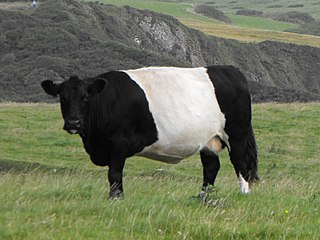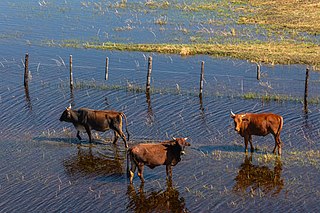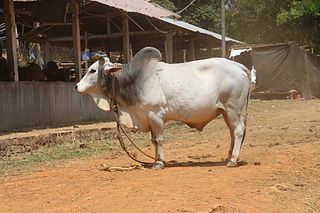Related Research Articles

The Charolais or Charolaise is a French breed of taurine beef cattle. It originates in, and is named for, the Charolais area surrounding Charolles, in the Saône-et-Loire department, in the Bourgogne-Franche-Comté region of eastern France.

The Longhorn or British Longhorn is a British breed of beef cattle characterised by long curving horns. It originated in northern England, in the counties of Lancashire, Westmorland and Yorkshire, and later spread to the English Midlands and to Ireland. It was originally a slow heavy draught animal; cows gave a little milk, although high in fat. In the eighteenth century Robert Bakewell applied his methods of selective breeding to these cattle, which for a short time became the predominant British breed. Both the numbers and the quality of the breed declined throughout the nineteenth century and for much of the twentieth. A breed society was formed in 1878, and a herd-book published in that year.

The Lakenvelder is a Dutch and German breed of dairy cattle. It is reported from the Netherlands and Belgium, but may be extinct in Germany.

The Mishima is a critically-endangered Japanese breed of beef cattle. It is found only on Mishima Island, some 50 km (31 mi) north-west of Hagi, in Yamaguchi Prefecture, Japan. It is one of six native Japanese cattle breeds, and one of two small populations that have never been cross-bred with Western cattle, the other being the Kuchinoshima breed from Kuchinoshima island in the Tokara Island group.

The Tswana is an indigenous breed or group of breeds of beef cattle of Botswana. It is a Sanga type, similar to Barotse and Tuli. The coat colour may be solid red or black, red pied or – less frequently – black pied. It is also present in South Africa. Animals of this breed are well adapted to hot, dry environments and have a high level of tick and heat tolerance.
The Indu-Brasil or Indo-Brazilian is a Brazilian breed of zebuine beef cattle. It was bred in the early twentieth century in the Triângulo Mineiro in the western part of Minas Gerais state, and particularly in the area surrounding Uberaba. It was originally known as the Induberaba. It derives from imported Indian zebuine cattle, principally Gir and Kankrej. It was formerly an important beef breed, but in the twenty-first century is an endangered breed. It is characterised by particularly large ears, perhaps the largest seen in any breed of cattle.

The Pinzgauer is a breed of domestic cattle from the Pinzgau region of the federal state of Salzburg in Austria. It has distinctive colouring, with chestnut-brown sides and white back and underside. It was in the past a triple-purpose breed, raised for meat, milk and draught use. There is a naturally polled sub-type, the Jochberg Hummel. In 2007 the breed was not considered by the FAO to be at risk.

The Japanese Black is a breed of Japanese beef cattle. It is one of six Japanese cattle breeds, and one of the four Japanese breeds known as wagyu, the others being the Japanese Brown, the Japanese Polled and the Japanese Shorthorn. All wagyu cattle derive from cross-breeding in the early twentieth century of native Japanese cattle with imported stock, mostly from Europe. In the case of the Japanese Black, the foreign influence was from European breeds including Braunvieh, Shorthorn, Devon, Simmental, Ayrshire and Holstein.

The Japanese Brown is a breed of small Japanese beef cattle. It is one of six native Japanese cattle breeds, and one of the four Japanese breeds known as wagyu, the others being the Japanese Black, the Japanese Polled and the Japanese Shorthorn. All wagyu cattle derive from cross-breeding in the early twentieth century of native Japanese cattle with imported stock, mostly from Europe. In the case of the Japanese Brown, the principal foreign influence was from the Korean Hanwoo and Swiss Simmental breeds.

The Malvi or Malavi, also known as Manthani or Mahadeopuri, is breed of zebu cattle from the Malwa plateau in western Madhya Pradesh, in central India. It is a good draught breed; the milk yield of the cows is low.

The Swedish Red-and-White, Swedish: Svensk Röd och Vit Boskap, frequently abbreviated to SRB, is a Swedish breed of dairy cattle. It was created in the 1920s by crossing the Swedish Red Pied and Swedish Ayrshire breeds.
The Swedish Red Pied, Swedish: Rödbrokig Svensk Boskap, frequently abbreviated to RSB, was a Swedish breed of dairy cattle. It is now considered extinct. It was merged in the 1920s with the Swedish Ayrshire breed to create the Swedish Red-and-White, which is one of the principal dairy breeds of Sweden.

The Swedish Polled, Swedish: Svensk Kullig Boskap, often abbreviated to SKB, is a Swedish breed of domestic cattle. It was created in 1937 from two different Swedish cattle breeds, the Swedish Red Polled and the Fjäll. Breeders did not accept the new classification, and continued to maintain separate bloodlines as before. Of the two constituent breeds, the Swedish Red Polled received official recognition in 2004, while the Fjäll has divided into two sub-breeds, the Fjällnära Boskap and the Svensk Fjällras.

The Japanese Shorthorn is a breed of small Japanese beef cattle. It is one of six native Japanese cattle breeds, and one of the four Japanese breeds known as wagyu, the others being the Japanese Black, the Japanese Brown and the Japanese Polled. All wagyu cattle derive from cross-breeding in the early twentieth century of native Japanese cattle with imported stock, mostly from Europe. In the case of the Japanese Shorthorn, the principal foreign influence was from the Shorthorn, with some contribution from the Ayrshire and Devon breeds.
The Japanese Polled is a critically-endangered breed of small Japanese beef cattle. It is one of six native Japanese cattle breeds, and one of the four Japanese breeds known as wagyu, the others being the Japanese Black, the Japanese Brown and the Japanese Shorthorn. All wagyu cattle derive from cross-breeding in the early twentieth century of native Japanese cattle with imported stock, mostly from Europe. In the case of the Japanese Polled, the principal foreign influence was from the Scottish Angus breed.

The Kuchinoshima is a critically-endangered Japanese breed of small feral cattle. It is found only on Kuchinoshima Island, in the Tokara Islands in Kagoshima Prefecture in southern Japan. It is one of six native Japanese cattle breeds, and one of two small populations that have never been cross-bred with Western cattle, the other being the Mishima breed from Mishima Island north-west of Hagi, in Yamaguchi Prefecture.

The Red Brangus is an American breed of hybrid beef cattle, with both taurine and indicine genetic heritage. Development began in Texas in the 1940s. It is a colour variant of the Brangus, a hybrid of American Angus and Brahman cattle, and differs from it only in colour. There are two herd-books, one international and one American. For international registration the animal must be of 5/8 Angus and 3/8 Brahman descent; in the United States, it may be any mix of the two breeds, but registration is conditional on inspection.
References
- 1 2 3 4 5 6 7 8 9 10 11 12 13 14 15 16 17 18 19 20 21 22 23 24 25 26 27 28 29 30 31 32 33 34 35 36 37 38 39 40 41 42 43 44 45 46 47 48 49 50 51 52 53 54 55 56 57 58 59 60 61 62 63 64 65 66 67 68 69 70 Barbara Rischkowsky, Dafydd Pilling (editors) (2007). List of breeds documented in the Global Databank for Animal Genetic Resources, annex to The State of the World's Animal Genetic Resources for Food and Agriculture. Rome: Commission on Genetic Resources for Food and Agriculture, Food and Agriculture Organization of the United Nations. ISBN 9789251057629. Archived 23 June 2020.
- 1 2 3 4 5 6 7 8 9 10 11 12 13 14 15 16 17 18 19 20 21 22 23 24 25 26 27 28 29 30 31 32 33 34 35 36 37 38 39 40 41 42 43 44 45 46 47 48 49 50 51 52 53 54 55 56 57 58 59 60 61 62 63 64 65 66 67 68 69 70 71 72 73 74 75 76 Breeds reported by United States of America: Cattle. Domestic Animal Diversity Information System of the Food and Agriculture Organization of the United Nations. Accessed January 2023.
- 1 2 3 4 5 6 7 8 9 10 11 12 13 14 15 16 17 18 19 20 21 22 23 24 25 26 27 G.X. Zhang, Z.G. Wang, W.S. Chen, C.X. Wu, X. Han, H. Chang, L.S. Zan, R.L. Li, J.H. Wang, W.T. Song, G.F. Xu, H.J. Yang, Y.F. Luo (2007). Genetic diversity and population structure of indigenous yellow cattle breeds of China using 30 microsatellite markers. Animal Genetics. 38: 550–559. doi:10.1111/j.1365-2052.2007.01644.x.